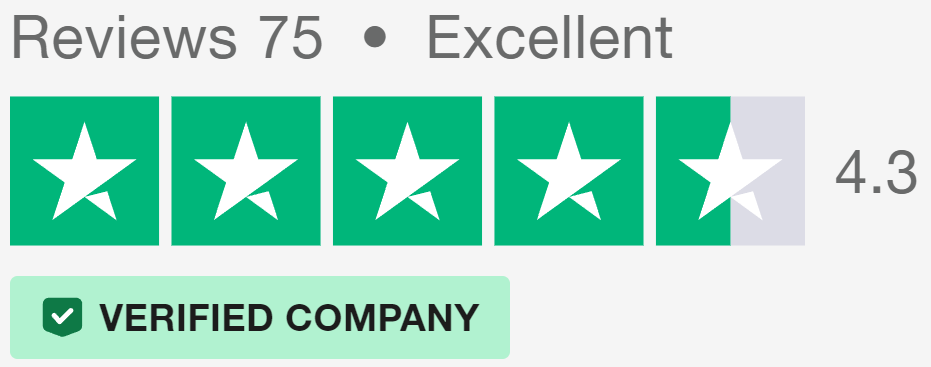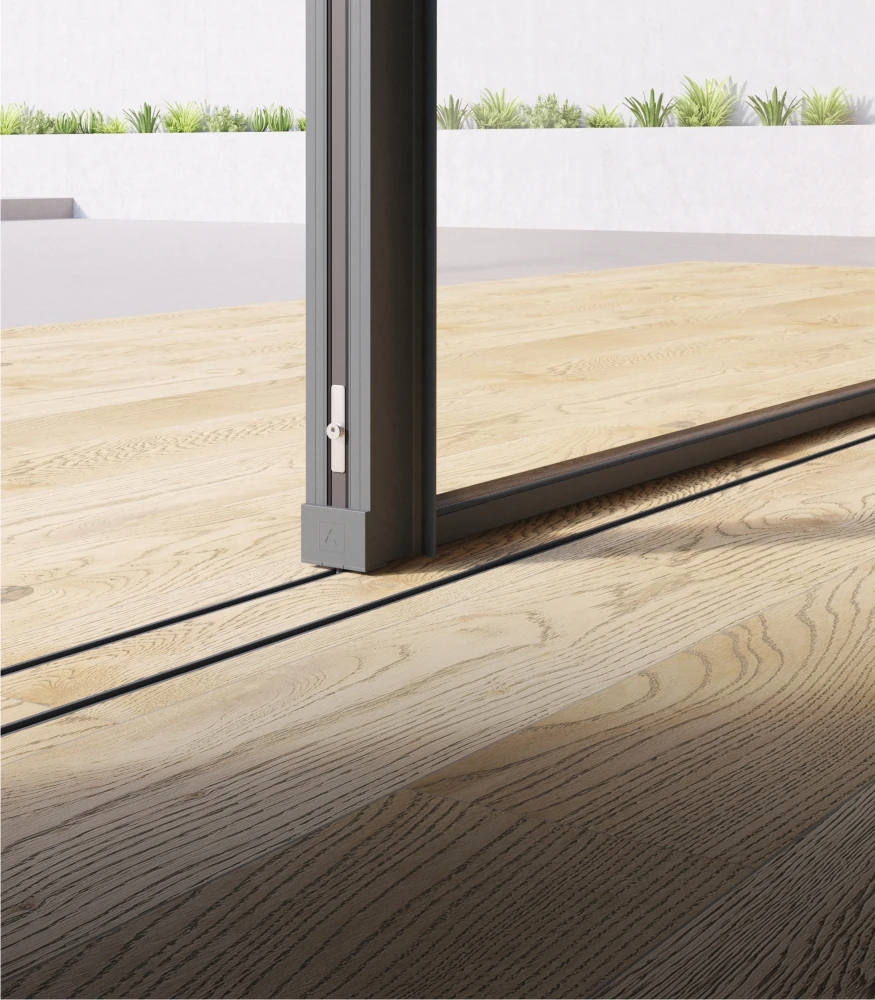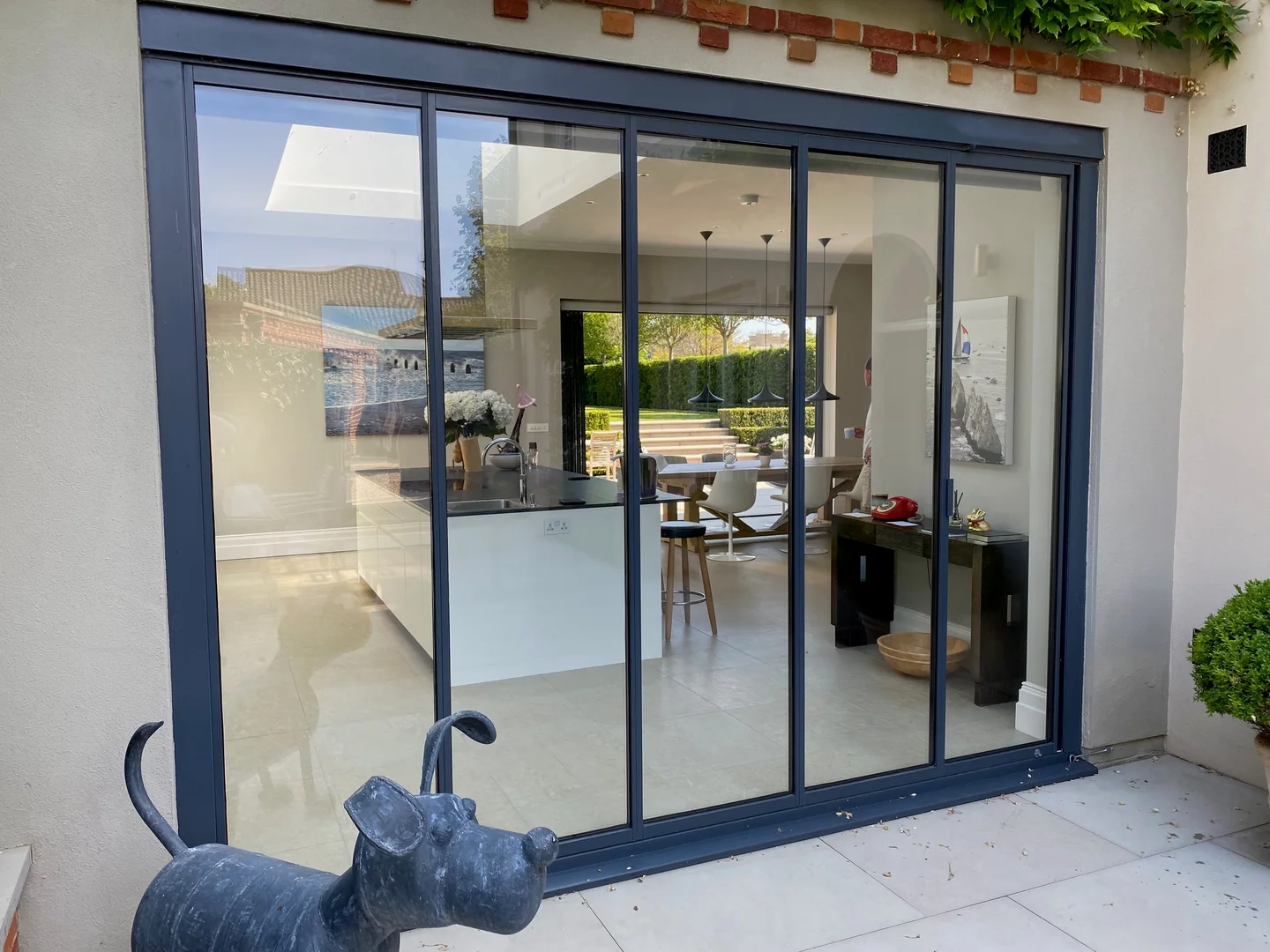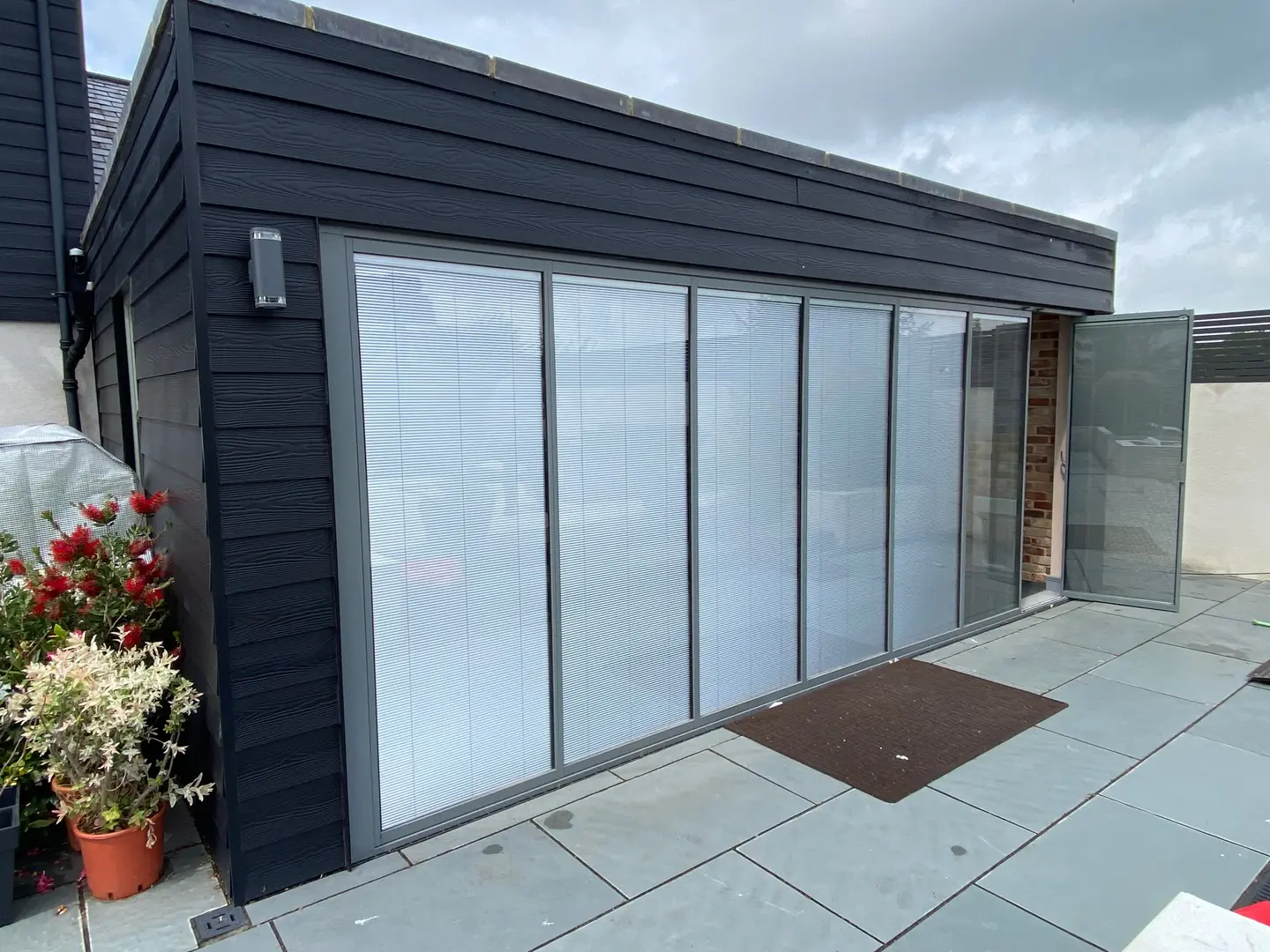Grey Patio Doors: Materials, Colours & Style Guide
Table of Contents

Material Types for Grey Patio Doors
Modern grey patio doors come in three main materials, each offering distinct benefits for different homes and budgets.

Aluminium Grey Patio Doors
Grey aluminium sliding doors rank among the most popular choices for British homes, thanks to their robust powder-coated finish and slim frame design. A typical frame measures just 40mm wide, letting you fit bigger glass panels into smaller openings. Powder coating bonds the grey pigments deep into the metal through an electrical charging process, rather than simply painting the surface.
The strength-to-weight ratio of aluminium makes it ideal for larger openings where other materials might buckle or warp. Manufacturers apply the grey finish in a specialised facility where the aluminium goes through multiple treatment stages—cleaning, pre-treatment, powder application, and curing in a high-temperature oven. This multi-step process means the colour won’t chip, fade, or peel off over time.
Grey uPVC Sliding Doors
Modern grey uPVC doors use either foiled finishes or spray-applied coatings to achieve their colour. The foiling process wraps the frames in a textured, coloured layer that bonds permanently to the plastic underneath. Spray-coated finishes offer a smoother look but need more careful handling during installation to avoid scratches.
Raw uPVC starts life as a white material, so manufacturers must add the grey finish during production. The newest foiling techniques can mimic the look of grey aluminium framed patio doors while keeping costs lower. These modern foils resist UV damage and maintain their colour for years, making them a practical choice for south-facing installations.
Timber Doors in Grey
Paint manufacturers now produce specialist external wood stains and paints in grey shades specifically formulated for wooden door frames. These modern finishes penetrate deeply into the grain, protecting the wood while adding colour. Oak and hardwood frames take grey stains particularly well, showing subtle variations in tone where the grain pattern shows through.
Painted timber needs more upkeep than metal or plastic, but it brings character to period properties where modern materials might look out of place. Some manufacturers pre-finish their wooden frames in the factory using spray-applied grey coatings, which last longer than brush-painted finishes applied on site.
Choosing Your Material
Material selection should match both your budget and your home’s architecture. While grey aluminium doors suit contemporary builds perfectly, older properties often benefit from the softer appearance of painted wood. The frame material you pick will also determine the range of grey shades available to you—aluminium offers the widest selection, while timber limits you to paint colours that work well with wood.
The Science of Grey Door Finishes
Powder coating stands as one of the most advanced finishing methods available for grey patio doors, offering superior durability compared to wet paint systems.
What is Powder Coating?
The process begins when raw aluminium frames arrive at specialist coating facilities. Technicians first clean the metal thoroughly using phosphate solutions, removing any oils or residues that might prevent proper bonding. Next, they apply electrostatically charged grey powder particles, which stick evenly to the frame’s surface. The coated frames then move into large industrial ovens, where temperatures reach 200°C, melting the powder into a solid coating that chemically bonds with the metal underneath.
Powder coated aluminium doors resist scratches and chips because the coating becomes part of the frame’s surface structure rather than sitting on top like traditional paint. Leading manufacturers offer warranties of up to 25 years on their powder-coated finishes, reflecting the coating’s exceptional durability. The coating’s thickness varies between 60 and 120 microns – much thicker than standard paint – which helps protect the metal from corrosion.

Textured vs Smooth Grey Surfaces
Surface texture plays a vital part in how grey patio doors look in different lighting conditions. Smooth finishes reflect more light, making the grey appear brighter and more metallic. These surfaces show fingerprints more readily but clean easily with a microfibre cloth. Textured finishes scatter light, creating a softer, more matte appearance that hides minor scratches and smudges better than smooth surfaces.
Modern manufacturing techniques can create various textured patterns, from fine grain to more pronounced stippling. These textures not only add visual interest but also improve grip when operating heavy or tall patio doors. Some manufacturers offer dual-finish options where the external face features a weatherproof texture while the internal surface remains smooth for easier cleaning.
Woodgrain Effect Grey Doors
Recent advances in finishing technology have made it possible to combine grey colours with realistic wood textures. These specialised finishes use multi-layer coating systems where the woodgrain pattern sits beneath a clear protective layer. The result mimics the natural variation found in painted timber but requires none of the maintenance associated with real wood.
The woodgrain effect works particularly well on grey sliding doors in traditional properties, where purely modern finishes might look out of place. Manufacturers achieve this effect through a process called sublimation, where heat and pressure transfer the pattern onto the surface. Unlike simple embossing, this method creates depth and variation in the texture that looks authentic even up close.
Coastal Grey Finishes
Properties near the coast need special protection against salt spray and intense UV exposure. Manufacturers have developed marine-grade grey finishes that incorporate additional protective layers and UV-resistant pigments. These specialist coatings use different chemical formulations from standard powder coats, with modified polyester resins that resist salt corrosion.
Grey Shades and Light
Natural light changes throughout the day, altering how grey patio doors appear in your space.
How Sunlight Changes Grey Doors
Morning sunlight tends to bring out the warmer undertones in grey sliding doors, while midday sun shows their true colour most accurately. North-facing installations often appear darker and cooler than the same shade installed in a south-facing room. The changing angle of the sun creates subtle shifts in how the grey looks – a shade that seems perfect at noon might appear too dark by evening.
Artificial lighting also plays an important but often overlooked part in how grey patio doors look after sunset. LED spotlights can make grey appear colder and more blue-toned, while traditional incandescent bulbs bring out warmer undertones. Professional installers often recommend testing door samples under different lighting conditions before making a final choice. Some manufacturers now provide lighting demonstration areas in their showrooms specifically for this purpose.
Warm vs Cool Grey Tones
Grey comes in an extensive range of undertones, from warm greiges with brown undertones to cool blue-greys. Warm greys work particularly well with brick and stone, creating a softer contrast than stark cool greys. These warmer shades often contain tiny amounts of red, yellow, or brown pigments – invisible to the naked eye but noticeable in how they respond to light.
Cool greys suit modern architecture with their crisp, clean appearance. These shades might incorporate subtle blue or green undertones that become more apparent in bright daylight. Large sliding doors in cool grey shades can make a bold architectural statement, especially when paired with white or pale rendered walls.
Metallic Grey Options
Metallic finishes add depth to grey patio doors through tiny aluminium particles suspended in the coating. These particles catch and reflect light differently depending on viewing angle, creating subtle movement across the surface. Some premium metallic coatings use multiple particle sizes to create more complex light-catching effects.
The latest metallic grey finishes resist fingerprints better than earlier versions thanks to improved surface treatments. Manufacturers achieve this by adding a microscopic texture to the finish – invisible to the touch but effective at dispersing oils that would otherwise leave marks. These advanced coatings maintain their lustre for years without needing special cleaning products.
Light Reflection Values
Each grey shade comes with a specific Light Reflection Value (LRV), measuring how much light bounces off the surface. Lighter greys might have LRVs around 50%, while darker anthracite greys can measure below 10%. This number helps predict how the colour will perform in different lighting conditions and how it might influence room temperature. Professional installers use these values to help customers choose appropriate shades for their specific situation.
Modern grey patio doors often combine different surface finishes to manage light reflection. The outer face might feature a slightly textured finish to reduce glare, while the inner frame uses a smoother finish that reflects more light into the room. Some manufacturers now offer dual-finish options where the external and internal colours can be specified separately, allowing for more creative design possibilities.
Matching Grey Patio Doors
Many homeowners start their grey patio doors project by trying to match existing windows or interior design elements.
Popular Grey Door Shades
RAL 7016 Anthracite Grey remains the most requested shade for grey sliding patio doors in Britain, offering a deep, rich tone that works well with most architectural styles. RAL 7015 Slate Grey provides a slightly warmer alternative that’s gaining popularity, especially in rural settings. For those seeking lighter options, RAL 7040 Window Grey creates a softer look while still maintaining the contemporary feel that makes grey doors so appealing.
Recent colour trends show growing interest in metallic variations of these classic shades. Pearl Mouse Grey adds subtle shimmer to the standard RAL 7048, while Graphite Grey Metallic brings depth to darker installations. These specialised finishes cost more than standard colours but offer unique visual interest that standard flat greys can’t match.
Matching Grey Windows with Grey Patio Doors
Coordinating new grey patio doors with existing grey windows requires careful attention to detail. Even small variations in shade can create jarring contrasts. The age of existing windows matters too – UV exposure can gradually lighten grey finishes, making exact matches with new installations challenging. Leading manufacturers now offer colour matching services where they analyse existing window colours to recommend the closest current finish options.
Paint suppliers have developed specific touch-up products for grey aluminium windows and doors, helping maintain consistent colour across all exterior joinery. These specialist paints use the same pigments as factory finishes, ensuring repairs and touch-ups remain invisible. Some companies even provide colour-matched mastic sealants to ensure every detail of the installation maintains colour consistency.
Two-Tone Grey Designs
Modern manufacturing allows for different grey shades on the interior and exterior faces of grey patio doors. This design flexibility lets homeowners choose darker external colours for striking kerb appeal while keeping lighter shades inside that work better with their flooring finish and interior colour schemes. Popular combinations include Anthracite Grey outside with Pearl Grey inside, or Slate Grey external frames paired with Light Grey interiors.
The latest grey patio doors can incorporate contrasting frame elements in different grey tones. Some designs use darker grey for the outer frame and lighter grey for the sliding panels, creating subtle depth. Other options include grey frames with black gaskets and hardware, adding definition to the overall design.
Frame Combinations
Advanced production methods now allow for more complex colour combinations within single frame systems. Manufacturers can apply different grey finishes to various frame components, creating sophisticated visual effects. The main frame might feature a dark grey exterior while mullions and transoms use lighter greys to define the glazing pattern. Some systems even offer tri-colour options, though these specialised finishes often extend production times.
Recent innovations in coating technology have improved the precision of two-tone finishes. New masking techniques ensure clean lines between different grey shades, while improved powder coating methods reduce the risk of cross-contamination between colours. These advances let manufacturers offer more intricate designs without compromising quality or durability.
Grey sliding doors have sparked a trend toward coordinated exterior schemes. Homeowners increasingly request matching grey gutters, fascias, and even garage doors to create cohesive facades. Some builders now specify complete grey exterior packages that include every element from window boards to coal vents, all finished in matching or complementary grey shades.
The psychology behind grey’s popularity in door design reveals interesting patterns. Lighter greys create a sense of space and openness, while darker greys convey sophistication and modernity. Mid-tones offer practical benefits, hiding dirt and fingerprints while maintaining a smart appearance. Understanding these psychological impacts helps inform choices about grey tones for different areas of the home.
Grey Patio Doors in Your Space
Choosing the right grey sliding doors depends heavily on your home’s architecture and surrounding environment.
Period Properties
Victorian and Edwardian homes present unique challenges when installing grey patio doors. The key lies in selecting profiles that complement original architectural features rather than competing with them. Slimmer frames with traditional glazing bars often work well, while overly modern designs can look out of place. RAL 7042 Traffic Grey offers a softer appearance that suits period properties better than stark contemporary greys.
Many older properties feature bay windows or detailed stonework that new doors need to work alongside. Manufacturers now produce heritage-style grey patio doors with deeper profiles and decorative elements that mirror traditional timber joinery. These designs incorporate modern thermal performance while maintaining period aesthetics through careful attention to sightlines and proportions.

Glass Extensions
Modern glass rooms demand careful thought about frame colours and proportions. Grey patio doors in these spaces need to strike a balance between providing structural support and appearing visually lightweight. Lighter grey shades like RAL 7035 can make frames less noticeable, while darker greys create bold architectural statements.
Structural glazing systems often incorporate level threshold options that let tiled floors run straight through from inside to out. The latest designs use flush floor tracks that hide drainage channels beneath removable covers, keeping the grey frame elements minimal and architectural. Some systems even offer completely recessed top tracks that disappear into the ceiling void.
Colour Schemes
Interior design trends increasingly use grey sliding doors as a starting point for wider colour schemes. Deep charcoal frames work particularly well with pale walls and natural materials like oak or stone. Warmer grey shades complement earthy colour palettes and traditional materials, while cooler greys pair naturally with contemporary whites and industrial finishes.
Many designers now specify grey patio doors to anchor broader material palettes. The frames can echo grey veining in marble floors or pick up tones from concrete or stone features. Metallic grey finishes add sophisticated highlights to minimalist spaces, reflecting light and adding depth without overwhelming the design.
Door handles and other hardware elements need careful selection to complement grey frames. Brushed stainless steel offers a modern look that resists fingerprints, while matt black creates stronger contrast. Some manufacturers now produce hardware in exact RAL matches to their frame colours, allowing for completely coordinated installations.
Garden Design
Grey patio doors influence how indoor and outdoor spaces work together visually. Lighter greys can help merge the boundaries between house and garden, while darker shades frame views like pictures. Garden designers often use these frame colours to inform planting choices – silver-leaved plants like lavender complement mid-grey doors naturally.
Landscaping materials should work in harmony with door colours. Light grey granite paving can pick up tones from door frames, creating visual connections across outdoor spaces. Dark grey slate or basalt creates contrast with lighter frames while complementing anthracite grey installations.
Plant selection near grey patio doors deserves special attention. Green foliage provides natural contrast with grey frames, while white or purple flowering plants can create stunning seasonal displays. Climbing plants need careful management around door frames – some varieties can damage powder-coated finishes if allowed to attach directly to the metal.
We’d Love to Help You
Vision Glass Doors is a designer, manufacturer, and installer of premium door systems. We are a family run business with over 20 years’ experience and 5,000 installations across the UK.
Our leading range of door systems include Ultra Slim – Slide and Turn Doors, Slimline Sliding Patio Doors and Frameless Glass Doors. Suitable for various internal and external applications, they are applicable to residential and commercial projects.
Click Quick Quote Online for a free quotation within 24 hours. Alternatively, call or email us on 01582 492730 or at info@visionglassdoors.co.uk.

